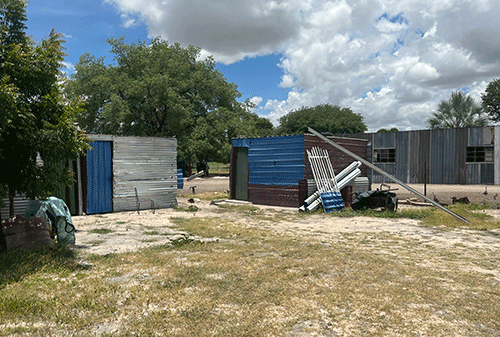The office of the Auditor General, tasked to evaluate infrastructure maintenance at government schools, found public schools countrywide to be in a perilous state.
Floors with holes, broken windows, no ceilings, cracked walls, makeshift classrooms and hostels, damaged lights switches, blocked sewers and drains, and non-functioning and damaged roofs sum up the infrastructure used to educate the future generation.
The dire state in which most government schools find themselves was uncovered by the office between 2017 and 2021.
“[The audit objective was] to assess whether State schools’ infrastructure and facilities under the Ministry of Education, Arts and Culture are well maintained and that annual work programmes and inspections are carried out,” part of the report reads.
At the heart of the audit’s justification is assuring lawmakers, taxpayers, learners and parents as well as other stakeholders that schools are maintained according to the highest standards to ensure accountability and transparency of funds generated from taxpayers and other incomes are put to good use.
In addition, reasonable assurance would also provide more insight for decision-makers to make informed decisions.
A close analysis of the report shows that maintenance at most public schools remains a foreign concept.
In his findings, the AG, Junias Kandjeke, does not mince his words.
His position was after conducting a compliance audit on the evaluation of infrastructure maintenance at government schools, their compliance with the Education Act of 2001, Maintenance Framework and Cabinet Decision No: 7th/06.07.10.002.
The auditors sampled 25 schools from five regions, identified as high risk due to public outcry and a number of concerns raised.
High risks
In Zambezi, Kandjeke’s staff visited Katima Combined School (CS), Ngweze Secondary School (SS), Masokotwani CS, Caprivi Senior Secondary School (SSS), Mafuta CS, Simata SSS and Sanjo SSS.
What is peculiar in Zambezi is eight schools were assessed and site visit reports were produced.
The reports were empty as far as maintenance is concerned, as they did not contain the results of assessment as required by policy.
As for Kavango East, Maria Mwengere, Linus Shashipapo and Ndiyona were evaluated.
“The audit found that Kavango East Regional Council’s directorate of education did not maintain the schools selected for audit purposes,” the auditors discovered.
It was recommended that: “The accounting officer [regional director] should ensure that site inspections should be conducted and site visit reports contain the results of the condition assessment of school infrastructure as per the said policy.”
A maintenance assessment was also carried out at Sikarosompo Primary School (PS), Levi Hakusembe SS, Kandjimi Murangi SS and Mururani SS in the Kavango West.
Both the Kavango east and west regions also failed to provide their budgets for the 2017/18 and 2017/18 to 2020/21 financial years.
The other region is Ohangwena, where Shituwa SS, Eenhana SSS, Oshikunde CS, Oshela SS and Ohakafiya CS were tested.
In Omusati, John Shekundja CS, Oshatotwa CS, Shaanika Nashilongo SS, David Sheehama SS, Uushwa CS and Onembaba CS’ compliance was scrutinised.
During the audit, five regions had a computerised management system that facilitates maintenance, planning, implementation and reporting.
The system is a policy requirement.
The regions do not practice preventative maintenance, it was found.
It was recommended that regional directors in the regions must ensure routine and proactive maintenance is performed regularly.
“The evidence is sufficient and appropriate to provide the basis for my conclusion that the subject matter is not compliant in all material respect with the applicable criteria,” Kandjeke concluded.
Findings
At Katima CS, the auditors were greeted by damaged roofs, broken windows, basic plumbing issues and blocked sewers and drains.
The situation was not different at Ngweze SSS, where dilapidated ablution facilities, walls with cracks and holes in some instances, cracked floors and damaged notice boards were the order of the day.
At Masokotuani CS, still in Zambezi, classrooms had potholes and non-functioning toilet tubs, while Caprivi SSS was flooded with sewerage water, broken windows and a damaged ceiling.
Simata SSS had damaged light switches and notice boards, non-replacement of door locks and hinges, potholes on floors, broken windows and cracks in the walls.
In neighbouring Kavango East, Ndiypona SSS had damaged roofs, notice boards and ceilings, potholes and cracks on the floor and damaged switches.
At Kandjimi Murangi SSS, learners wake up to blocked sewers and drains, leaking geysers, ablution facilities that are out of order and wrecked ceilings since 2018.
It gets worse in Kavango West.
At Sikarosompo PS, there are corrugated zinc-iron and wooden poles makeshift classrooms and dormitories, potholes in classrooms and damaged door locks.
The reality is similar at Mururani, where the notorious Red Line begins.
Mururani SS’ windows are broken, walls are cracked, floors have holes and there are plumbing issues.
In Ohangwena, Eenhana SSS had cracks on the wall, broken windows and potholes on the floors, while Shituwa SS had damaged lights, falling ceilings and makeshift infrastructure as hostels and classrooms.
Oshatotwa CS in Omusati had severely cracked walls externally and internally.
Criteria
The audit criteria were benchmarked against the Education Act and the classification of schools and hostels, the Ministerial Maintenance Policy, Condition Standard Ratings, Planned Maintenance, Unplanned Maintenance and if there were adequate budgetary allocations for maintenance purposes. – emumbuu@nepc.com



